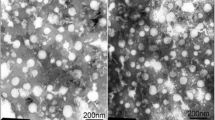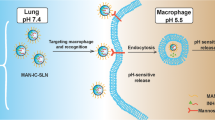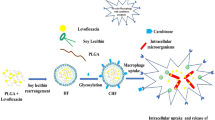Abstract
The present study aimed at developing a drug delivery system targeting the densest site of tuberculosis infection, the alveolar macrophages (AMs). Rifampicin (RFP)-loaded solid lipid nanoparticles (RFP-SLNs) with an average size of 829.6 ± 16.1 nm were prepared by a modified lipid film hydration method. The cytotoxicity of RFP-SLNs to AMs and alveolar epithelial type II cells (AECs) was examined using MTT assays. The viability of AMs and AECs was above 80 % after treatment with RFP-SLNs, which showed low toxicity to both AMs and AECs. Confocal Laser Scanning Microscopy was employed to observe the interaction between RFP-SLNs and both AMs and AECs. After incubating the cells with RFP-SLNs for 2 h, the fluorescent intensity in AMs was more and remained longer (from 0.5 to 12 h) when compared with that in AECs (from 0.5 to 8 h). In vitro uptake characteristics of RFP-SLNs in AMs and AECs were also investigated by detection of intracellular RFP by High performance liquid chromatography. Results showed that RFP-SLNs delivered markedly higher RFP into AMs (691.7 ng/mg in cultured AMs, 662.6 ng/mg in primary AMs) than that into AECs (319.2 ng/mg in cultured AECs, 287.2 ng/mg in primary AECs). Subsequently, in vivo delivery efficiency and the selectivity of RFP-SLNs were further verified in Sprague–Dawley rats. Under pulmonary administration of RFP-SLNs, the amount of RFP in AMs was significantly higher than that in AECs at each time point. Our results demonstrated that solid lipid nanoparticles are a promising strategy for the delivery of rifampicin to alveolar macrophages selectively.





Similar content being viewed by others
References
Aderem A, Underhill DM (1999) Mechanisms of phagocytosis in macrophages. Annu Rev Immunol 17:593–623. doi:10.1146/annurev.immunol.17.1.593
Albrecht C, Scherbart AM, Berlo Dv, Braunbarth CM, Schins RPF, Scheel J (2009) Evaluation of cytotoxic effects and oxidative stress with hydroxyapatite dispersions of different physicochemical properties in rat NR8383 cells and primary macrophages. Toxicol In Vitro 23(3):520–530. doi:10.1016/j.tiv.2009.01.005
Armstrong JA, Arcy Hart PD (1972) Response of cultured macrophages to Mycobacterium tuberculosis, with observations on fusion of lysosomes with phagosomes. J Exp Med 134(3):713–740
Bivas-Benita M, Zwier R, Junginger HE, Borchard G (2005) Non-invasive pulmonary aerosol delivery in mice by the endotracheal route. Eur J Pharm Biopharm 61(3):214–218
Bothamley G (2001) Drug treatment for tuberculosis during pregnancy: safety considerations. Drug Saf 24:553–565
Briones E, Isabel Colino C, Lanao JM (2008) Delivery systems to increase the selectivity of antibiotics in phagocytic cells. J Controlled Release 125(3):210–227. doi:10.1016/j.jconrel.2007.10.027
Chellat F, Merhi Y, Moreau A, Yahia LH (2005) Therapeutic potential of nanoparticulate systems for macrophage targeting. Biomaterials 26(35):7260–7275. doi:10.1016/j.biomaterials.2005.05.044
Chen J, Chen Z, Narasaraju T, Jin N, Liu L (2004) Isolation of highly pure alveolar epithelial type I and type II cells from rat lungs. Lab Invest 84(6):727–735
Chono S, Tanino T, Seki T, Morimoto K (2006) Influence of particle size on drug delivery to rat alveolar macrophages following pulmonary administration of ciprofloxacin incorporated into liposomes. J Drug Target 14(8):557–566. doi:10.1080/10611860600834375
Chono S, Tanino T, Seki T, Morimoto K (2007) Uptake characteristics of liposomes by rat alveolar macrophages: influence of particle size and surface mannose modification. J Pharm Pharmacol 59(1):75–80. doi:10.1211/jpp.59.1.0010
Chono S, Tanino T, Seki T, Morimoto K (2008) Efficient drug targeting to rat alveolar macrophages by pulmonary administration of ciprofloxacin incorporated into mannosylated liposomes for treatment of respiratory intracellular parasitic infections. J Controlled Release 127(1):50–58. doi:10.1016/j.jconrel.2007.12.011
Chuan JL, Gong T, Sun X, Zhang Z (2011) Preparation of rifampicin-solid lipid nanoparticles and evaluation of their cell specificity. West China J Pharm Sci 26(3):223–225
Conner SD, Schmid SL (2003) Regulated portals of entry into the cell. Nature 422(6927):37–44. doi:10.1038/nature01451
Crofton John (1960) Drug treatment of tuberculosisl. BMJ 2:370–373
Edelson JD, Shannon JM, Mason RJ (1988) Alkaline phosphatase: a marker of alveolar type II cell differentiation. Am J Respir Crit Care Med 138(5):1268–1275. doi:10.1164/ajrccm/138.5.1268
Ferrari G, Langen H, Naito M, Pieters J (1999) A coat protein on phagosomes involved in the intracellular survival of mycobacteria. Cell 97(4):435–447. doi:10.1016/s0092-8674(00)80754-0
He C, Hu Y, Yin L, Tang C, Yin C (2010) Effects of particle size and surface charge on cellular uptake and biodistribution of polymeric nanoparticles. Biomaterials 31(13):3657–3666. doi:10.1016/j.biomaterials.2010.01.065
Hirota K, Hasegawa T, Hinata H, Ito F, Inagawa H, Kochi C, Soma G-I, Makino K, Terada H (2007) Optimum conditions for efficient phagocytosis of rifampicin-loaded PLGA microspheres by alveolar macrophages. J Controlled Release 119(1):69–76. doi:10.1016/j.jconrel.2007.01.013
Hirota K, Hasegawa T, Nakajima T, Inagawa H, Kohchi C, Soma G-I, Makino K, Terada H (2010) Delivery of rifampicin–PLGA microspheres into alveolar macrophages is promising for treatment of tuberculosis. J Controlled Release 142(3):339–346. doi:10.1016/j.jconrel.2009.11.020
Krist LFG, Kerremans M, Koenen H, Blijleven N, Eestermans IL, Calame W, Meyer S, Beelen RHJ (1995) Novel isolation and purification method permitting functional cytotoxicity studies of macrophages from milky spots in the greater omentum. J Immunol Methods 184(2):253–261. doi:10.1016/0022-1759(95)00096-s
Lawlor C, Kelly C, O’Leary S, O’Sullivan MP, Gallagher PJ, Keane J, Cryan SA (2011) Cellular targeting and trafficking of drug delivery systems for the prevention and treatment of MTb. Tuberculosis 91(1):93–97. doi:10.1016/j.tube.2010.12.001
Li Y-Z, Sun X, Gong T, Liu J, Zuo J, Zhang Z-R (2010) Inhalable microparticles as carriers for pulmonary delivery of thymopentin-loaded solid lipid nanoparticles. Pharm Res 27(9):1977–1986. doi:10.1007/s11095-010-0201-z
McKinney J, Hoener zu Bentrup K, Munoz-Elias E, Chan WT, Swensonēǵ D, Sacchettinik J (2000) Persistence of Mycobacterium tuberculosis in macrophages and mice requires the glyoxylate shunt enzyme isocitrate lyase. Nature 406(6797):735–738
Nafee N, Schneider M, Schaefer UF, Lehr C-M (2009) Relevance of the colloidal stability of chitosan/PLGA nanoparticles on their cytotoxicity profile. Int J Pharm 381(2):130–139. doi:10.1016/j.ijpharm.2009.04.049
Natarajan K, Kundu M, Sharma P, Basu J (2011) Innate immune responses to M. tuberculosis infection. Tuberculosis 91(5):427–431. doi:10.1016/j.tube.2011.04.003
Nguyen L, Pieters J (2005) The Trojan horse: survival tactics of pathogenic mycobacteria in macrophages. Trends Cell Biol 15(5):269–276. doi:10.1016/j.tcb.2005.03.009
Onoshita T, Shimizu Y, Yamaya N, Miyazaki M, Yokoyama M, Fujiwara N, Nakajima T, Makino K, Terada H, Haga M (2010) The behavior of PLGA microspheres containing rifampicin in alveolar macrophages. Colloids Surf B 76(1):151–157. doi:10.1016/j.colsurfb.2009.10.036
Pallanza R, Arioli V, Furesz S, Bolzoni G (1967) Rifampicin: a new rifamycin. II. Laboratory studies on the antituberculous activity and preliminary clinical observations. Arzneimittelforschung 17(5):529–534
Panchagnula R, Sood A, Sharda N, Kaur K, Kaul CL (1999) Determination of rifampicin and its main metabolite in plasma and urine in presence of pyrazinamide and isoniazid by HPLC method. J Pharm Biomed Anal 18(6):1013–1020. doi:10.1016/s0731-7085(98)00112-5
Pandey R, Khuller GK (2005) Solid lipid particle-based inhalable sustained drug delivery system against experimental tuberculosis. Tuberculosis 85(4):227–234. doi:10.1016/j.tube.2004.11.003
Pandey R, Sharma S, Khuller G (2005) Oral solid lipid nanoparticle-based antitubercular chemotherapy. Tuberculosis 85(5–6):415–420. doi:10.1016/j.tube.2005.08.009
Post M, Smith BT (1988) Histochemical and immunocytochemical identification of alveolar type II epithelial cells isolated from fetal rat lung. Am J Respir Crit Care Med 137(3):525–530. doi:10.1164/ajrccm/137.3.525
Thomas CZ (2003) Molecular mechanisms regulating persistent Mycobacterium tuberculosis infection. Microbes Infect 5(2):159–167. doi:10.1016/s1286-4579(02)00083-7
Vergne I, Chua J, Singh SB, Deretic V (2004) Cell biology of Mycobacterium tuberculosis phagosome. Annu Rev Cell Dev Biol 20:367–394. doi:10.1146/annurev.cellbio.20.010403.114015
WHO (2010) Global Tuberculosis Control. Geneva
Wijagkanalan W, Kawakami S, Takenaga M, Igarashi R, Yamashita F, Hashida M (2008) Efficient targeting to alveolar macrophages by intratracheal administration of mannosylated liposomes in rats. J Controlled Release 125(2):121–130
Acknowledgments
The work was funded by the National Basic Research Programs of China (973 program, No: 2009CB930300 and 2012CB724002) and supported by the State Key Program of the National Natural Science of China (No: 81130060). The authors would like to thank W.R. Webb, ISTM Guy Hilton Research Centre, Keele University Medical School, for editorial assistance.
Conflict of interest
The authors report no conflicts of interest.
Author information
Authors and Affiliations
Corresponding authors
Rights and permissions
About this article
Cite this article
Chuan, J., Li, Y., Yang, L. et al. Enhanced rifampicin delivery to alveolar macrophages by solid lipid nanoparticles. J Nanopart Res 15, 1634 (2013). https://doi.org/10.1007/s11051-013-1634-1
Received:
Accepted:
Published:
DOI: https://doi.org/10.1007/s11051-013-1634-1




